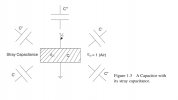Andy Eagle
Fractal Fanatic
Yes no finish.
I do it... Not sure if it's better than copper foil or not but I think it's definitely easier.Okay,
Your thoughts on painting the control and pickup cavities with shielding paint?
I am using SD single coils in neck and bridge.
Thanks.
I've never had great success with shielding paint, nor have I seen any guitars with shielding paint that have achieved zero resistance. Copper has produced the best results in my experience. It's tedious but not having to worry about it doing what it's supposed to is worth it to me. I use 3" copper tape and cut strips or pieces to size, soldering a few points where the pieces come together. I don't recall the thickness but it's pretty thin, just a bit thicker than aluminum foil.Okay,
Your thoughts on painting the control and pickup cavities with shielding paint?
I am using SD single coils in neck and bridge.
Thanks.
Insufficient shielding in your tinfoil hat?I wouldn't do any shielding to start with as it is not usually needed with good components. IF you have problems I would look in to reducing the hum in your rig first. But on the subject of copper tape or graphite paint I would always say the graphite paint because the copper tape affects the tone. Yes I know that some electrical engineers on here may tell me it can't but in tests you can hear a difference .Same as what cap to use they will rightly tell you capacitance is capacitance regardless of the different materials used to create it, but I not sure how to explain that a nice PIO or wax paper rolls the treble in a more pleasing mix not just killing all the top in the first instance even on the same pot. Please chime in if anyone can explain way this is?
Ho HoInsufficient shielding in your tinfoil hat?
Stray capacitance.I wouldn't do any shielding to start with as it is not usually needed with good components. IF you have problems I would look in to reducing the hum in your rig first. But on the subject of copper tape or graphite paint I would always say the graphite paint because the copper tape affects the tone. Yes I know that some electrical engineers on here may tell me it can't but in tests you can hear a difference .Same as what cap to use they will rightly tell you capacitance is capacitance regardless of the different materials used to create it, but I not sure how to explain that a nice PIO or wax paper rolls the treble in a more pleasing mix not just killing all the top in the first instance even on the same pot. Please chime in if anyone can explain way this is?

Yup. EVERYTHING is capacitively connected to EVERYTHING ELSE.Stray capacitance.
View attachment 84606
The paper in oil cap is physically larger, and, usually for tone pot values, a sheet wrapped up in a roll, which introduces another factor: inductance. There is also the ESR of the insulating materials to consider. All of these minute differences in materials and construction make a small difference. Sometimes that difference is audible to all, sometimes it is audible to a few 'lucky' folks, and sometimes it really doesn't make a difference detectable by the ear.Can you go in to detail as to why the same value cap in different materials sounds different please. Not being an electronics engineer I need more than the diagram.
What Joe said…Can you go in to detail as to why the same value cap in different materials sounds different please. Not being an electronics engineer I need more than the diagram.
Thank you. Sounds similar to the coating material on wire affecting the size of the pickup coil and therefor the tone. This explains why the physically large caps do tend to sound obviously different .The paper in oil cap is physically larger, and, usually for tone pot values, a sheet wrapped up in a roll, which introduces another factor: inductance. There is also the ESR of the insulating materials to consider. All of these minute differences in materials and construction make a small difference. Sometimes that difference is audible to all, sometimes it is audible to a few 'lucky' folks, and sometimes it really doesn't make a difference detectable by the ear.
